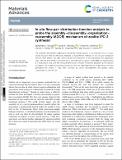Files in this item
In situ flow pair distribution function analysis to probe the assembly-disassembly-organisation-reassembly (ADOR) mechanism of zeolite IPC-2 synthesis
Item metadata
| dc.contributor.author | Russell, Samantha E. | |
| dc.contributor.author | Henkelis, Susan E. | |
| dc.contributor.author | Vornholt, Simon M. | |
| dc.contributor.author | Rainer, Daniel N. | |
| dc.contributor.author | Chapman, Karena W. | |
| dc.contributor.author | Morris, Russell E. | |
| dc.date.accessioned | 2021-11-05T13:30:07Z | |
| dc.date.available | 2021-11-05T13:30:07Z | |
| dc.date.issued | 2021-10-13 | |
| dc.identifier | 276565961 | |
| dc.identifier | 0dec06cd-a224-41cd-a814-78031e6ec2af | |
| dc.identifier | 000710574500001 | |
| dc.identifier | 85121436513 | |
| dc.identifier.citation | Russell , S E , Henkelis , S E , Vornholt , S M , Rainer , D N , Chapman , K W & Morris , R E 2021 , ' In situ flow pair distribution function analysis to probe the assembly-disassembly-organisation-reassembly (ADOR) mechanism of zeolite IPC-2 synthesis ' , Materials Advances , vol. Advance Article . https://doi.org/10.1039/d1ma00335f | en |
| dc.identifier.issn | 2633-5409 | |
| dc.identifier.other | RIS: urn:9A9CF5E2ED8EDEA488589114A7C4F338 | |
| dc.identifier.other | ORCID: /0000-0001-7809-0315/work/102725421 | |
| dc.identifier.uri | https://hdl.handle.net/10023/24266 | |
| dc.description | The authors S. E. R., S. M. V., and R. E. M. would like to thank the European Research Council for funding opportunities under the Advanced Grant 787073. S. E. H., S. M. V. and D. N. R. would like to thank the EPSRC for funding (EP/K503162/1) (EP/K005499/1) (EP/N509759/1). R. E. M. further acknowledges the OP VVV “Excellent Research Teams” grant under project no. CZ.02.1.01/0.0/0.0/15_003/0000417 – CUCAM. | en |
| dc.description.abstract | The assembly–disassembly–organisation–reassembly (ADOR) process is an important tool to access zeolite structures that are otherwise unfeasible via hydrothermal methods. In situ flow pair distribution function (PDF) analysis has been used to probe the mechanism of the disassembly and organisation steps, with the disassembly a rapid step that is often difficult to capture. Zeolite UTL was hydrolysed by 6 M hydrochloric acid, with PDF measurements used to monitor framework alterations as the reaction proceeded. The resulting disassembly mechanism shows an initial rapid removal of germanium from the germanium-rich double 4 rings (d4r), followed by silicon rearrangement and gradual silanol condensation to form IPC-2P. | |
| dc.format.extent | 7 | |
| dc.format.extent | 5560881 | |
| dc.language.iso | eng | |
| dc.relation.ispartof | Materials Advances | en |
| dc.subject | QD Chemistry | en |
| dc.subject | DAS | en |
| dc.subject.lcc | QD | en |
| dc.title | In situ flow pair distribution function analysis to probe the assembly-disassembly-organisation-reassembly (ADOR) mechanism of zeolite IPC-2 synthesis | en |
| dc.type | Journal article | en |
| dc.contributor.sponsor | European Research Council | en |
| dc.contributor.sponsor | EPSRC | en |
| dc.contributor.sponsor | US Department of Energy | en |
| dc.contributor.institution | University of St Andrews. School of Chemistry | en |
| dc.contributor.institution | University of St Andrews. EaSTCHEM | en |
| dc.identifier.doi | https://doi.org/10.1039/d1ma00335f | |
| dc.description.status | Peer reviewed | en |
| dc.identifier.grantnumber | 787073 | en |
| dc.identifier.grantnumber | EP/K005499/1 | en |
| dc.identifier.grantnumber | DE-AC02-06CH11357 | en |
This item appears in the following Collection(s)
Items in the St Andrews Research Repository are protected by copyright, with all rights reserved, unless otherwise indicated.

